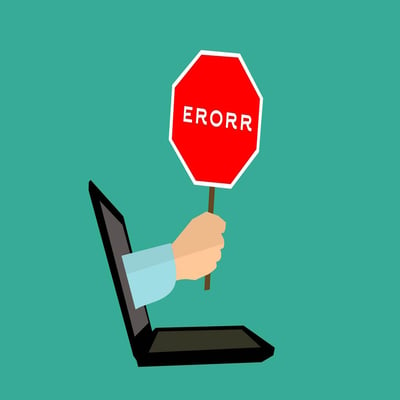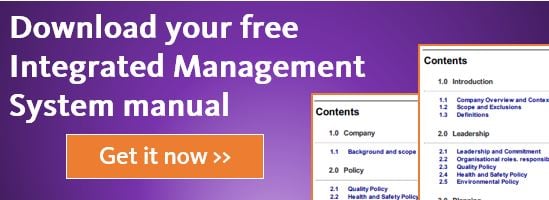What happens when something goes wrong? And how will you manage outcomes?
With careful reading of clause 8.7.1 you’ll notice that the standard says you need to ensure that “outputs that do not conform to their requirements are identified and controlled to prevent their unintended use or delivery.”
In other words, outputs are not just products and services - they could be anything. Documents that have errors, verbal quotes that aren’t understood, incorrect stock levels and invoicing errors are all common examples non-conforming outputs.

Outputs Affect All Customers
This clause also hints at another important factor to bear in mind when identifying non-conforming outputs – outputs affect all customers, both external and internal.
It’s not just the end user of your product or service that we’re talking about here. All businesses have internal and external customers which at some point will have to deal with shonky outputs. This clause covers all customers.
The clause then states that you “…shall take appropriate action based on the nature of the nonconformity and its effect on the conformity of products and services”. In essence, let the size and scope of the problem dictate your response to it.
Example
If we have a major error in our Mango software and our clients are unable to use Mango at all, then our action will be to urgently fix the issue by patching the software immediately. If, however, the non-conformity is a minor bug and the client can still use Mango just fine, then our action will be different – we may choose to fix the issue at the next software update later in the month, for instance. Your response should always be appropriate to the magnitude of the problem at hand.
Next, when dealing with non-conforming outputs you need to consider how you will:
- Correct the problem;
- Segregate, contain, return or suspend the product and service;
- Inform the customer;
- Get a concession from the customer to deliver the non-conforming product to them.
Non-Conformance Reports (NCR's)
Finally the standard requires you to record what you have done about the non-conformance. Typically companies record these things in a report. There are a myriad of forms you could use. Call them whatever you like but for this blog let’s call them NCRs (Non-Conformance Reports).
In your NCR, you must:
1. Describe in detail what the issue is. Many companies find this task difficult to achieve. There’s definitely an art to outlining the problem - you have to describe it so that others can understand at a glance what it means. Having your team use a tool like WWWWH (who, what, where, when, how) can be a big help in achieving clarity.
2. Describe what actions you have taken to correct the problem. This could include some immediate actions and perhaps some root cause analysis.
3. Record any concessions from the customer in accepting the non-conforming product. The customer will have to authorise this acceptance of the inferior product or service (and remember, the customer could be either an internal or external).
4. Identify the authority who has decided on the action to fix the non-conformity.
For example, here at Mango we use our own Mango product to record non-conformances. The form built into Mango we it called a QIF (Quality Improvement Form). The non-conformances are reported in the online QIF form and then allocated to a Co-ordinator. The Co-ordinator allocates the issue to an investigator to address the issue and to do some root cause analysis. The Coordinator reviews what has been done and signs it off to authorise the the fix. It’s all online and visible to all of the Management layers in the company.
This “Non-conforming Outputs” clause can be a pot of gold for you and your business. Carefully managing non-conformance reports can directly increase your profits: as I said in this blog, “[non-conforming reports] are feedback, a cause for pause, a chance to look at not just the detail of what you do, but also the big picture. But deal with NCRs sloppily and they have the power to put departments at loggerheads, get customers bad-mouthing you and reduce your profits.”
Takeaways
Here is a list of takeaways that will help you meet clause 8.7:
- Determine what outputs that do not conform will be identified and controlled.
- Work out how you will:
- correct the problem;
- segregate, contain, return or suspend the product and service;
- inform the customer;
- get concessions.
- Create an NCR form.
- Use the form to capture valuable information to increase profits.
View previous blogs in this series "How to Implement a QMS and Achieve ISO 9001 Certification":
How to Implement a QMS and Achieve ISO 9001 Certification - Part 1: Introduction
How to Implement a QMS and Achieve ISO 9001 Certification - Part 2: Customer Focus
How to Implement a QMS and Achieve ISO 9001 Certification - Part 3: Leadership
How to Implement a QMS and Achieve ISO 9001 Certification - Part 4: Engagement of People
How to Implement a QMS and Achieve ISO 9001 Certification - Part 5: Process Approach
How to Implement a QMS and Achieve ISO 9001 Certification - Part 6: Improvement
How to Implement a QMS and Achieve ISO 9001 Certification - Part 7: Evidence Based Decision Making
How to Implement a QMS and Achieve ISO 9001 Certification - Part 8: Relationship Management
How to Implement a QMS and Achieve ISO 9001 Certification - Part 12: Clause 5.2 Policy
How to Implement a QMS and Achieve ISO 9001 Certification - Part 15: Clause 6.2 Objectives
How to Implement a QMS and Achieve ISO 9001 Certification - Part 16: Clause 7.1 Resources
.png?width=200&height=51&name=image%20(2).png)




